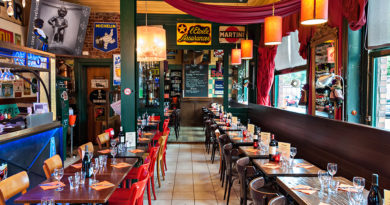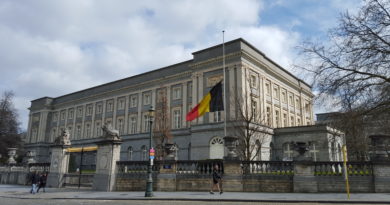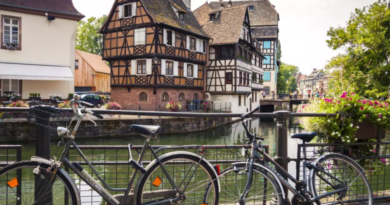Ixelles Museum: more than 65,000 visitors for Robert Doisneau in Brussels
In 1979, Susan Sontag sat next to Bernard Pivot and four celebrated photographers on the set of Apostrophes, a well known French cultural TV show, where she talked about her influential collection of essays called: On photography. “Taking pictures and observing one’s photographs, those are some of the most essential activities to try to understand modernity,” she said. One of the photographers on the set was Robert Doisneau.
From October 19th until February 4th, the Ixelles Museum presented the works of the great French photographer. On February 1st, along with a couple dozen people, I joined one of the guided tours that the museum organised in the realm of the Nocturnes or late-evening visits. “Out of thousands and and thousands of pictures in the archive,” said Sophie, our guide, “the pictures were selected with the help of Robert Doisneau’s daughters, Anette and Francine, and the museum’s curator, Claire Leblanc.”
After a short introduction, the group walked on to explore the first section of the exhibition. On the walls hung black and white prints of Parisian daily existence in the 30’s and 40’s, the minutiae of quotidian life in France. One of the first pictures we stopped to analyze was one of rubble, fragments of stone lying on top of each other in a somewhat geometrical shape. Sophie asked if we could guess why Doisneau had chosen such a subject. “The reason is rather simple, though somewhat escapable. He was a very shy man. At the beginning of his career, he didn’t dare ask people if he could take their picture.”
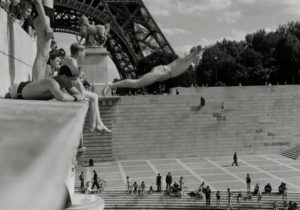
Further on we saw a portrait picture of general Charles de Gaulle, walking away from the Arc de Triomphe and towards the camera, probably taken shortly after liberation day. “Whenever I see this one, I think of all the photographers crowding the general, more or less where we’re standing now, trying to take a memorable picture. And one of them was Robert Doisneau. He was in his thirties.”
Like many other photographers in their early years, Doisneau worked in advertising, one of his main customers being Renault. One of the photographs on display shows a car from above, in the centre of the picture, a balanced and symmetric composition. Though precise and creative, forever meticulous, Doisneau would not last long on the job. “He was fired because he always delivered late. He couldn’t help it. Other projects got his attention,” said Sophie, before leading the way towards the section where we could see one of Doisneau’s passion: colour photography.
In 1960 he was commissioned by Fortune magazine to fly to Southern California and capture one of the latest ambitions of the American upper class: the placement golf courses in the desert. It was the ultimate conquest for the wealthy. But for Doisneau, the motivation lay elsewhere. He was able to put his hands on a colour-film camera, an unmissable opportunity for him. From modest city dwellers, living in run-down, often crammed apartments, to villas with sunbathers lying next to a large pool, the silky surface of the water mirroring the dunes in the distance. Nowhere had the contrast been as marked as it was in his Palm Springs series.

On the second floor, we saw his Ateliers d’artistes series, where pictures of the workshops of Tinguely, Niki de Saint Phalle, Utrillo, Giacometti, Brancusi, among others, hung on the walls. “For a while, his main residence was in the Montrouge district,” said Sophie, “and plenty of these artists lived in the neighbourhood, too.” Fernand Léger, whose work will be shown at Bozar Centre for Fine Arts as of the 9th of February, lived in the building next to Doisneau’s. But it was his encounter in 1945 with Le Point founder, Pierre Betz, that proved crucial. “It was he who opened the doors for me to Picasso‘s house,” said Doisneau in an interview. “The same with Braque and Henri Laurens, and also Colette.”
Before the museum closed for the night, I went back to study one of the most emblematic pictures taken by Doisneau: Le baiser de l’hotel ville, where two lovers kiss each other, oblivious to the noise of the cars, to the eyes of everyone around them. “They were actors,” is what Sophie told us. “It was all staged. A commissioned job for Life Magazine in 1950.” For a long time I stood there, watching the image, only a few feet away, my head tilted. Like many viewers before me, I had wished Doisneau had caught on film the fragile moment when two lovers become one, their bodies overpowered by the muscled river of emotions that could trample reason. An instant when nothing else in the world mattered, not even the beauty of Paris.
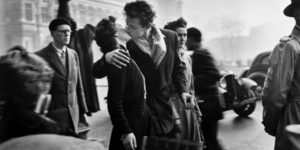
“We want the photographer to be a spy in the house of love and of death, and those being photographed to be unaware of the camera,” wrote Susan Sontag in her book, Regarding the Pain of Others. “No sophisticated sense of what photography is or can be will ever weaken the satisfaction of a picture of an unexpected event seized in mid-action by an alert photographer.”
Good to know:
- The Ixelles Museum 2nd to the 4th of March, before closing for renovations until 2021.
- From October 2017 to February 2018, the Robert Doisneau exhibition welcomed over 65,000 visitors.

